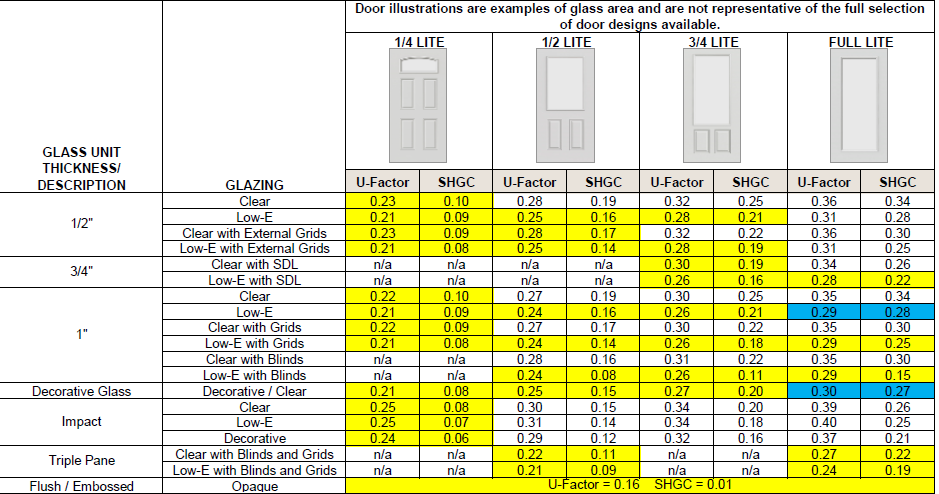Part 4: Fenestration Windows, Doors, and Skylights – Impact on Heat Loss and Heat Gain
The IECC (International Energy Conservation Code) include this definition:
FENESTRATION. Products classified as either vertical fenestration or skylights.
Skylight. Glass or other transparent or translucent glazing material installed at a slope of less than 60 degrees (1.05 rad) from horizontal.
Vertical fenestration. Windows (fixed or moveable), opaque doors, glazed doors, glazed block and combination opaque/glazed doors composed of glass or other transparent or translucent glazing materials and installed at a slope of at least 60 degrees (1.05 rad) from horizontal.
In Part 3, the previous J, D, and S discussion, the focus was thermal factors; R-values, U-factors, and solar heat gain coefficient (SHGCs). In this discussion, we will explore how window, skylight, or door U-factors are used to calculate the impact fenestration products have on the building heat loss and heat gain.
Recalling the National Fenestration Rating Council (NFRC) label noted in that previous discussion, the NFRC label includes the U-factor, SHGC, Visible Transmittance and Air Leakage ratings for the fenestration assembly. U-factor, the thermal transmittance for the assembly, is expressed as: BTU/hr., per degree Fahrenheit, per square foot, or: [(BTU) / (hour ∙ ⁰F ∙ ft2)]. When multiplied by the design temperature difference, the product is the Heat Transfer Multiplier or HTM.
HTM = U-factor X Temperature Difference
Temperature Difference (TD) is the difference between inside and outside temperature
HTM X Area = Heat loss through that component or assembly
This may appear confusing; however, applying this calculation to the windows of a typical home will help clarify. Calculating the heat loss through windows for this typical home, with a total window area of 300 square feet, with new energy code compliant windows, a 70⁰F inside temperature, and 10⁰F outside temperature:
2015 IECC Code requirement for residential windows: 0.32 U-factor
Temperature Difference = 70⁰ – 10⁰ = 60⁰F
HTM = U-factor X TD = 0.32 X 60⁰F = 19.2 BTU/hr. ∙ ft2
For every square foot of window, there will be a 19.2 BTU/hr. heat loss each hour.
300 ft2 total window area:
19.2 X 300 = 5,760 BTU/hr. Total Heat Loss through windows
Calculating for the same window area; however, with old single pane aluminum framed glass.
Single pane clear glass, metal frame: 1.27 U-factor
HTM = 1.27 X 60⁰ = 76.2 BTU/hr. ∙ ft2 A HTM four times greater than the 0.32 windows.
76.2 X 300 = 22,860 BTU/hr. Total Heat Loss through windows
Of course, the performance and impact skylights and doors have on the building heat loss and heat gain is calculated and included with windows, as all are fenestration.
Please note – all these calculations are for heat conduction through the building components. Using this same procedure, we identify the U-factor for each wall, floor, and ceiling component, multiply by the temperature difference, followed with multiplying by the area of each component. After identifying the loss through each component, adding all together, we obtain the heat loss by conduction through the entire envelope. Additionally, in the summer months, a heat gain occurs, where the interior gains heat from the hot outside environment, is calculated using a similar procedure.
Other losses or gains due to air movement (infiltration and ventilation) through the envelope will be discussed in a future discussion.
New Code compliant windows in this typical home when compared with 40+ year-old windows, reduced the heat loss through the windows by 17,100 BTU/hr., a 75% reduction in window heat loss.
Considering the improvements made in the insulation and air sealing throughout the entire construction of the home, it is obvious why a load calculation must be performed on every home, when HVAC systems are installed, both new construction and replacement. Please consider the following general comments on Fenestration products:
- Site built windows common in commercial buildings and some contemporary home designs will have significantly higher (poorer) U-factors, due to the conductive nature of aluminum.
- Manufacturers produce aluminum frame material with either a single or double thermal break plastic/nylon material which will improve the performance of the frame and the overall window assembly: however, typically not to a level equal to vinyl, fiberglass, or composite materials.
- For further information on site-built windows, see the video from our Lunch & Learn series.
Metal or fiberglass foam insulated entrance doors with wood thermal breaks around the edges often have U-factors in the 0.12-0.17 range, much better than windows. If a window ‘lite’ is added into part of the door, the performance is reduced. This chart from Jeld-Wen lists an opaque door with an 0.16 U-factor and 0.01 SHGC, with slightly reduced performance where glass ‘lites’ are added.

Considering the R-value for windows and skylights typically around R-3, doors in a range as low as R-2.5 and as high as R-7, it quite apparent the fenestration is the weakest component of the thermal envelope, especially compared to the walls with R-19 and higher, attics R-38 or R-49, and floors with a R-30.
As we continue to build better insulated homes, with continually improved windows and doors, it is imperative that accurate load calculations are performed for every new or thermally improved home.
Other factors impacting energy flow through the building thermal envelope will be considered in future discussions. Please let me know if you have questions or comments.
Brent Ursenbach
[email protected]

